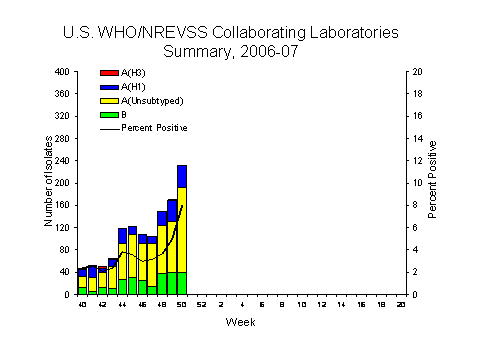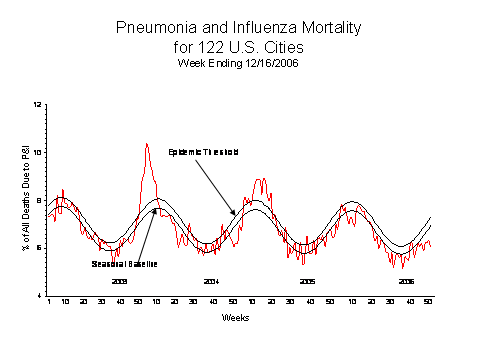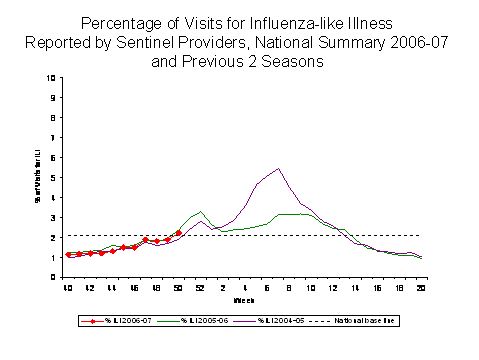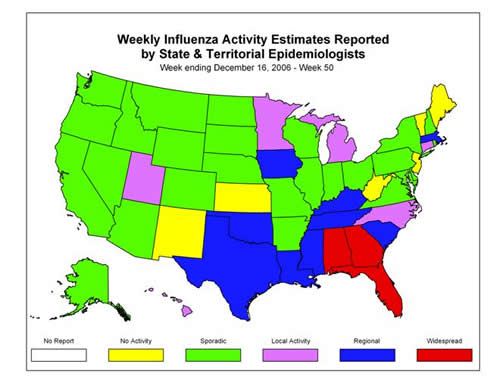Re: Outbreak of Regular Flu in Alabama
I can help. We track it for work anyway. As you noted, there are several different sources for information on influenza surveillance even within an agency for a specific geographic area. This leads to contradictions in the reports that we will try to explain.
JT
Announcement
Collapse
No announcement yet.
Outbreak of Regular Flu in Alabama
Collapse
X
-
Re: Outbreak of Regular Flu in Alabama
Yes Snickelfritz,
Gsgs point it out this morning (European Time Zone,
This is the Christmas Time, no doubt that analysis are done but their diffusion might be delayed by the Holidays.
Bad timing considering the Alabama outbreak.
We should create a thread and post Weekly National, Continental and Global influenza datas, a week per week having our own database.
We should do with weekly report a systematic postings for observations.
Thus avoiding confusion and rumors that could pop up.
Any volonteer??
Leave a comment:
-
Re: Outbreak of Regular Flu in Alabama
From CDC Weekly report:
From the original thread article:Influenza-Associated Pediatric Hospitalizations*:
Laboratory-confirmed influenza-associated pediatric hospitalizations are monitored in two population-based surveillance networks?: the Emerging Infections Program (EIP) and the New Vaccine Surveillance Network (NVSN). No influenza-associated pediatric hospitalizations have been reported from either network this season.
Is there a problem with surveillance here, or reporting, or what?Six children are on life support at Children's Hospital fighting severe cases of influenza, hospital officials said. The severity of the cases, many developing in the past two weeks, has raised concerns in Birmingham's pediatric medical community, said Dr. David Kimberlin, who specializes in pediatric infectious diseases at UAB.
Leave a comment:
-
Re: Outbreak of Regular Flu in Alabama
from:
http://www.cdc.gov/flu/weekly/weeklyarchives2002-2003/weekly20.htm
http://www.cdc.gov/flu/weekly/weeklyarchives2003-2004/weekly20.htm http://www.cdc.gov/flu/weekly/weeklyarchives2004-2005/weekly20.htm http://www.cdc.gov/flu/weekly/weeklyarchives2005-2006/weekly20.htm
http://www.cdc.gov/flu/weekly/weeklyarchives2006-2007/weekly50.htm
I calculate the probabilities of matching the USA-vaccine as:
2002/2003 : 580/588 = 98.6%
2003/2004: 114/991 = 11.5%
2004/2005: 339/920 = 36.8%
2005/2006: 474/828 = 57.2%
2006/2007: (16/42 = 38.1%)
from:
http://www.eiss.org/cgi-files/figures2002.cgi?year=2003&week=20®ion=Europe&ty pe=v
http://www.eiss.org/cgi-files/figures2002.cgi?year=2004&week=20®ion=Europe&ty pe=v
http://www.eiss.org/cgi-files/figures2002.cgi?year=2005&week=20®ion=Europe&ty pe=v
http://www.eiss.org/cgi-files/figures2002.cgi?year=2006&week=20®ion=Europe&ty pe=v
http://www.eiss.org/cgi-files/figures2002.cgi?year=2006&week=50®ion=Europe&ty pe=v
I calculate the probabilities of matching the European-vaccine as:
2002/2003 :419/872 = 48.1%
2003/2004: 3/913 = 0.3%
2004/2005: 122/398 = 30.7%
2005/2006: 813/2195 = 37.0%
2006/2007: (21/26 = 80.8%)
when you are vaccinated each year, the chances are better, since the protection
holds more than 1 year.
Leave a comment:
-
Re: Outbreak of Regular Flu in Alabama
so, it seems that 21 from 26 samples in Europe (the other 5 match last year's vaccine) and 15 from 42 samples in USA do match the current vaccine.
I couldn't get the world data with FLUNET.
Leave a comment:
-
Re: Outbreak of Regular Flu in Alabama
Gsgs,
Here are the datas for this week in US
Weekly Report: Influenza Summary Update
Week ending December 16, 2006-Week 50- <LI id=email><SCRIPT type=text/javascript> var WindowObjectReference; // global variable function openRequestedPopup() { document.url = location.href WindowObjectReference = window.open("http://www.bt.cdc.gov/scripts/emailprint/emailthispage.asp?title=" + document.title + "&url=" + document.url + "&channel=FddbDbmdCCID " + "&prop23=EcoliO157DbmdCCID" + "&prop24=EcoliSpinach2006DbmdCCID", "DescriptiveWindowName", "height=320,width=576,status=yes,toolbar=no,menuba r=no,location=no,scrollbars= yes,resizable=yes"); } </SCRIPT>Email this page <LI id=print>Printer-friendly version <LI id=govdel>Get email updates New!
 RSS feed
RSS feed
NEW!
During week 50 (December 10 ? December 16, 2006)*, influenza activity increased in the United States. Among specimens tested by U.S. World Health Organization (WHO) and National Respiratory and Enteric Virus Surveillance System (NREVSS) collaborating laboratories for influenza, 8.0% were positive. Three states reported widespread influenza activity; nine states reported regional influenza activity; six states reported local influenza activity; 26 states, the District of Columbia, and New York City reported sporadic influenza activity; and six states reported no influenza activity. The reporting of reporting widespread or regional influenza activity increased from four states for week 49 to 12 states for week 50. On a national level, laboratory and outpatient influenza-like illness (ILI) surveillance data indicated an increase from week 49 to week 50, and ILI was above its baseline for the first time this season. However, the percent of deaths due to pneumonia and influenza remained below baseline level.
Laboratory Surveillance*:
During week 50, WHO and NREVSS laboratories reported 2,909 specimens tested for influenza viruses, 232 (8.0%) of which were positive: 39 influenza A (H1) viruses, one influenza A (H3), 152 influenza A viruses that were not subtyped, and 40 influenza B viruses.
Since October 1, 2006, WHO and NREVSS laboratories have tested a total of 33,030 specimens for influenza viruses and 1,218 (3.7%) were positive. Among the 1,218 influenza viruses, 962 (79%) were influenza A viruses and 256 (21%) were influenza B viruses. Two hundred thirty-four (24%) of the 962 influenza A viruses have been subtyped: 222 (95%) were influenza A (H1) viruses and 12 (5%) were influenza A (H3) viruses. Of the 1,218 influenza positive tests reported this season, 503 (41%) have been reported from Florida.
Antigenic Characterization:
CDC has antigenically characterized 42 influenza viruses [10 influenza A (H1), one influenza A (H3), and 31 influenza B viruses] collected by U.S. laboratories since October 1, 2006.Influenza A (H1)[10]It is too early in the influenza season to determine which influenza viruses will predominate or how well the vaccine and circulating strains will match.? Eight of the 10 viruses were characterized as A/New Caledonia/20/99-like, which is the influenza A (H1) component of the 2006-07 influenza vaccine.Influenza A (H3)
? Two of the 10 viruses showed somewhat reduced titers with antisera produced against A/New Caledonia/20/99.? Eight of the 10 viruses were characterized as A/New Caledonia/20/99-like, which is the influenza A (H1) component of the 2006-07 influenza vaccine.Influenza B (B/Victoria/02/87 and B/Yamagata/16/88 lineages)[31]
? Two of the 10 viruses showed somewhat reduced titers with antisera produced against A/New Caledonia/20/99.Victoria lineage [18]
? Eighteen (58%) of the 31 influenza B viruses characterized belong to the B/Victoria lineage of viruses.o Seven of these 18 viruses were similar to B/Ohio/01/2005, the B component of the 2006-07 influenza vaccine.Yamagata lineage [13]
o Eleven of these 18 viruses showed somewhat reduced titers with antisera produced against B/Ohio/01/2005.
? Thirteen (42%) of the 31 influenza B viruses characterized belong to the B/Yamagata lineage of viruses.
Pneumonia and Influenza (P&I) Mortality Surveillance*:
During week 50, 6.1% of all deaths were reported as due to pneumonia or influenza. This percentage is below the epidemic threshold of 7.3% for week 50.
Influenza-Associated Pediatric Mortality*:
No influenza-associated pediatric deaths were reported for week 50, and no deaths have been reported for the 2006-07 influenza season.
Influenza-Associated Pediatric Hospitalizations*:
Laboratory-confirmed influenza-associated pediatric hospitalizations are monitored in two population-based surveillance networks<SUP>?</SUP>: the Emerging Infections Program (EIP) and the New Vaccine Surveillance Network (NVSN). No influenza-associated pediatric hospitalizations have been reported from either network this season.
Influenza-like Illness Surveillance*:
During week 50, 2.2%*** of patient visits to U.S. sentinel providers were due to ILI. This percentage is above the national baseline**** of 2.1%. On a regional level**, the percentage of visits for ILI ranged from 1.0% to 5.0%. Four regions reported ILI above their region-specific baseline****: the New England region reported 1.3% compared to its baseline of 1.2%, the South Atlantic region reported 2.5% compared to its baseline of 2.3%, the East South Central region reported 5.0% compared to its baseline of 2.4%, and the West South Central region reported 4.1% compared to its baseline of 3.0%.
Influenza Activity as Assessed by State and Territorial Epidemiologists*:
During week 50, the following influenza activity<SUP>??</SUP> was reported:? Widespread activity was reported by three states (Alabama, Florida, and Georgia).--------------------------------------------------------------------------------
? Regional activity was reported by nine states (Iowa, Kentucky, Louisiana, Massachusetts, Mississippi, Oklahoma, South Carolina, Tennessee, and Texas).
? Local activity was reported by six states (Connecticut, Hawaii, Michigan, Minnesota, North Carolina, and Utah).
? Sporadic activity was reported by the District of Columbia, New York City and 26 states (Alaska, Arizona, Arkansas, California, Colorado, Delaware, Idaho, Illinois, Indiana, Maryland, Missouri, Montana, Nebraska, New Hampshire, Nevada, New York, North Dakota, Ohio, Oregon, Pennsylvania, Rhode Island, South Dakota, Virginia, Washington, Wisconsin, and Wyoming).
? No influenza activity was reported by six states (Kansas, Maine, New Jersey, New Mexico, Vermont, and West Virginia).
<SCRIPT type=text/javascript> <!-- function popupnr(mylink, windowname, refocus) { var mywin, href; if (typeof(mylink) == 'string') href=""mylink; else href=mylink.href; mywin = window.open('', windowname, 'width=450,height=550,scrollbars=yes'); // if opened the window if ( mywin.closed || (! mywin.document.URL) || (mywin.document.URL.indexOf("about") == 0) ) mywin.location=href; else if (refocus) mywin.focus(); return false; } //--> </SCRIPT>Foot notes
<!-- InstanceEndEditable --><!-- InstanceBeginEditable name="date" -->Report prepared December 22, 2006<!-- InstanceEndEditable -->
Leave a comment:
-
Re: Outbreak of Regular Flu in Alabama
Thank you GsGs,
Here are the datas from gsgs link above
<TABLE cellSpacing=0 cellPadding=0 width=700 border=0><TBODY><TR><TD align=left width=750 bgColor=#0063c8 height=1>Graphs for Europe, season 2006/2007 </TD><TD width=1 bgColor=black height=1> </TD></TR><TR><TD width=1 bgColor=black height=1>
</TD></TR><TR><TD width=1 bgColor=black height=1> </TD><TD width=750 bgColor=#0063c8 height=3>
</TD><TD width=750 bgColor=#0063c8 height=3> </TD><TD width=1 bgColor=black height=1>
</TD><TD width=1 bgColor=black height=1> </TD></TR><TR><TD width=1 bgColor=black height=1>
</TD></TR><TR><TD width=1 bgColor=black height=1> </TD><TD width=750 bgColor=black height=1>
</TD><TD width=750 bgColor=black height=1> </TD><TD width=1 bgColor=black height=1>
</TD><TD width=1 bgColor=black height=1> </TD></TR><TR><TD width=1 bgColor=black height=1>
</TD></TR><TR><TD width=1 bgColor=black height=1> </TD><TD width=750 bgColor=#1d92ff height=3>
</TD><TD width=750 bgColor=#1d92ff height=3> </TD><TD width=1 bgColor=black height=1>
</TD><TD width=1 bgColor=black height=1> </TD></TR><TR><TD width=1 bgColor=black height=1>
</TD></TR><TR><TD width=1 bgColor=black height=1> </TD><TD width=750 bgColor=black height=1>
</TD><TD width=750 bgColor=black height=1> </TD><TD width=1 bgColor=black height=1>
</TD><TD width=1 bgColor=black height=1> </TD></TR><TR><TD width=1 bgColor=black height=1>
</TD></TR><TR><TD width=1 bgColor=black height=1> </TD><TD width=750 bgColor=white height=3>
</TD><TD width=750 bgColor=white height=3> </TD><TD width=1 bgColor=black height=1>
</TD><TD width=1 bgColor=black height=1> </TD></TR><TR><TD width=1 bgColor=black height=1>
</TD></TR><TR><TD width=1 bgColor=black height=1> </TD><TD align=middle width=750 bgColor=white height=1><TABLE><TBODY><TR><TD>The graphs below present virological data from Europe collected during the 2006/2007 influenza season. Click here if you would like to return to the previous page.</TD></TR></TBODY></TABLE>
</TD><TD align=middle width=750 bgColor=white height=1><TABLE><TBODY><TR><TD>The graphs below present virological data from Europe collected during the 2006/2007 influenza season. Click here if you would like to return to the previous page.</TD></TR></TBODY></TABLE>
 </TD><TD width=1 bgColor=black height=1>
</TD><TD width=1 bgColor=black height=1> </TD></TR><TR><TD width=1 bgColor=black height=1>
</TD></TR><TR><TD width=1 bgColor=black height=1> </TD><TD width=750 bgColor=white height=8>
</TD><TD width=750 bgColor=white height=8> </TD><TD width=1 bgColor=black height=1>
</TD><TD width=1 bgColor=black height=1> </TD></TR></TR><TR><TD width=1 bgColor=black height=1>
</TD></TR></TR><TR><TD width=1 bgColor=black height=1> </TD><TD width=750 bgColor=white height=8>
</TD><TD width=750 bgColor=white height=8> </TD><TD width=1 bgColor=black height=1>
</TD><TD width=1 bgColor=black height=1> </TD><TR><TD width=1 bgColor=black height=1>
</TD><TR><TD width=1 bgColor=black height=1> </TD><TD align=middle width=750 bgColor=white height=1><TABLE cellSpacing=0 cellPadding=0 border=0><TBODY><TR><TD>
</TD><TD align=middle width=750 bgColor=white height=1><TABLE cellSpacing=0 cellPadding=0 border=0><TBODY><TR><TD>
</TD></TR></TBODY></TABLE></TD><TD width=1 bgColor=black height=1> </TD></TR><TR><TD width=1 bgColor=black height=1>
</TD></TR><TR><TD width=1 bgColor=black height=1> </TD><TD width=750 bgColor=white height=8>
</TD><TD width=750 bgColor=white height=8> </TD><TD width=1 bgColor=black height=1>
</TD><TD width=1 bgColor=black height=1> </TD></TR></TR><TR><TD width=1 bgColor=black height=1>
</TD></TR></TR><TR><TD width=1 bgColor=black height=1> </TD><TD width=750 bgColor=white height=8>
</TD><TD width=750 bgColor=white height=8> </TD><TD width=1 bgColor=black height=1>
</TD><TD width=1 bgColor=black height=1> </TD><TR><TD width=1 bgColor=black height=1>
</TD><TR><TD width=1 bgColor=black height=1> </TD><TD align=middle width=750 bgColor=white height=1><CENTER><TABLE cellSpacing=0 cellPadding=0 width=590 border=0><TBODY><TR><TD>
</TD><TD align=middle width=750 bgColor=white height=1><CENTER><TABLE cellSpacing=0 cellPadding=0 width=590 border=0><TBODY><TR><TD>
Countries reporting antigenic characterisations are: England [n = 6], France [n = 16], Luxembourg [n = 2], Romania [n = 2]
Components of the 2006/2007 vaccine:
? an A/New Caledonia/20/99 (H1N1)-like virus (widely used is reassortant virus IVR-116 which is derived from A/New Caledonia/20/99 as an A/New Caledonia/20/99-like virus)
? an A/Wisconsin/67/2005 (H3N2)-like virus (reassortant viruses derived from A/Wisconsin/67/2005 (H3N2), i.e. IVR-142, and from A/Hiroshima/52/2005 as an A/Wisconsin/67/2005-like strain, i.e. NYMCX-161 and NYMCX-161B, are being used)
? a B/Malaysia/2506/2004-like virus (widely used vaccine virus is B/Malaysia/2506/2004)
</TD></TR></TBODY></TABLE></CENTER></TD><TD width=1 bgColor=black height=1> </TD></TR><TR><TD width=1 bgColor=black height=1>
</TD></TR><TR><TD width=1 bgColor=black height=1> </TD><TD width=750 bgColor=black height=1>
</TD><TD width=750 bgColor=black height=1> </TD><TD width=1 bgColor=black height=1>
</TD><TD width=1 bgColor=black height=1> </TD></TR></TBODY></TABLE>
</TD></TR></TBODY></TABLE>
Leave a comment:
-
Re: Outbreak of Regular Flu in Alabama
where do we get the involved virus strains from USA and other countries ?
For Europe, it's here:
http://www.eiss.org/cgi-files/figure...=Europe&type=v
edit: I also found this for USA:
http://www.weather.com/activities/he.../national.html
but they don't give the strains
OK, CDC has it. I saw this before, but forgot the link.
http://www.cdc.gov/flu/weekly/
Snowy was 1 minute faster ... see below. Thanks.
they also have a link to WHO-flunet:
http://gamapserver.who.int/GlobalAtl...oSelection.asp
type in the parameters and you can get your chartLast edited by gsgs; December 23, 2006, 04:37 AM.
Leave a comment:
-
Re: Outbreak of Regular Flu in Alabama
they may not be out of line for normal flu,but i would think its still worrying or possibly heart breaking for there mums and dads.....................and god help us if the pandemic ever happens(im not saing this is anything to do with BF).
if the services find it hard to cope in a normal flu season we dont stand a chance if there ever is a pandemic.
Leave a comment:
-
Re: SEVERE OUTBREAK OF VIRULENT FLU in ALABAMA
BTW -- I'm envying your Summer Solstice celebrations....Originally posted by AnneZI recall the flu season here in NZ was worse than usual.
Your season follows the one we have here.
Edit: Thanks for the NZ flu season link!
Leave a comment:
-
Re: SEVERE OUTBREAK OF VIRULENT FLU in ALABAMA
Here is a link to the bad NZ flu season.
Leave a comment:
-
Re: SEVERE OUTBREAK OF VIRULENT FLU in ALABAMA
I recall the flu season here in NZ was worse than usual.
Your season follows the one we have here.
Having trouble finding the link for it.
Leave a comment:
-
Re: SEVERE OUTBREAK OF VIRULENT FLU in ALABAMA
But, from the article...Originally posted by AnneZLooks as if flu season has arrived a little earlier than usual. The numbers are not out of line for normal flu.
"It is not the volume and not even the time of year that is jumping out at us," he said. "It is more that, for a number of otherwise healthy children, they are ending up on life support from the flu. The number of times that is occurring - it seems out of the ordinary, at least for now."
Leave a comment:
-
Re: SEVERE OUTBREAK OF VIRULENT FLU in ALABAMA
Looks as if flu season has arrived a little earlier than usual. The numbers are not out of line for normal flu.Originally posted by rutsuyasunNormally, cases of that number and severity are not reported until late January, February and March, she said.
Leave a comment:
-
Re: SEVERE OUTBREAK OF VIRULENT FLU in ALABAMA
Goodness! Thanks for posting this, rutsuyasun -- and thanks for following up. Let us know what you hear!
Leave a comment:




Leave a comment: